Hagi Castle
-Beautiful combination of mountain, sea and stone walls-
Overview
Name: Hagi castle (Hagi-jo)
Alias: Shigetsu-jo (Shigetsu castle)
Place: Horiuchi Hagi city, Yamaguchi
Location: 34.41879897352049, 131.38335409186246
Type: Flat Castle / Mountain Castle
Built: 16th century
Remaining remnants: Stone walls and water moats
Title: 100 famous Japanese castles
Hagi castle (萩城) is located at the seashore of Hagi city, one at the sea side of Sea of Japan in north east part Yamaguchi prefecture. Hagi area is a delta area of two kilometer square created by Abu-gawa river, and being surrounded by Hashimoto-gawa river and Matsumoto-gawa river which are the downstream of Abu-gawa river and mountains, it is a suitable place for defense.
Especially at the edge of the delta area, there is Shigetsu-yama mountain which is about 150 meter high, formerly might be island but connected to the land by sandbank plunged from mainland. Hagi castle is built utilizing this Shigetsu-yama mountain and connecting sand bank to delta area.
Originally Hagi area had been a small fishing village, and there was a fort built by Yoshimi clan which was the lord at Tsuwano castle (Shimane prefecture). Yoshimi clan was originally an important retainer of Ouchi clan which was the governor of Suo province and Nagato province (Yamaguchi prefecture), and after the fall of Ouchi clan because of the coup d’etat by their important general Harukata Sue (1521-1555), Yoshimi clan followed to Motonari Mouri (1497-1571) who defeated Harukata.
Motonari Mouri was originally a small local lord of Yoshida Koriyama castle (Hiroshima prefecture) in the northwest of Aki province (Hiroshima prefecture). Mouri clan was the leader of the party of neighbor small local lords, but highly affected by the movement of neighbor strong warlord such as Ouchi clan or Amago clan, which was the lord of Izumo province (Shimane prefecture).
But Motonari gradually grew their power beating other lords, and in 1540 Motonari rejected siege of Amago clan to Aki Koriyama castle and seized grabbed a clue for leap. In 1551, when Ouchi clan fell by the coup d’etat by their general Harukata Sue (1521-1555), Motonari at first showed attitude to support Harukata. But seeing that Harukata could not manage the situation well, Motonari decided to resist to Harukata insisting to make revenge of Ouchi clan.
Motonari had only limited army and inferior to Harukata, but Motonari lured large army of Harukata to narrow Itsukushima island by plot, and made a surprise attack to them in cooperation with Murakami naval clan in the stomy night. Harukata died at this surprise attack, and Motonari promoted to a strong warlord by this victory. Later Motonari fell Amago clan, and became the ruler of Chugoku region.
After the death of Motonari, his grand son Terumoto Mouri (1553-1625) became the next leader being supported by his talented two uncles Motoharu Kikkawa (1530-1586) and Takakage Kobayakawa (1533-1597). Mouri clan further expanded into east half of Chugoku region, but this expansion caused total conflict with central ruler Nobunaga Oda (1534-1582).
At first Mouri clan was prevalent, but gradually Nobunaga who beat backside enemies focused on Chugoku region, and Mouri clan gradually lost their territory before Hideyoshi Hashiba (1537-1598, later Hideyoshi Toyotomi), a regional commander of Nobunaga.
By 1582, Mouri clan lost east half of Chugoku region, and was forced to the corner of corruption. Nobunaga planned to march to Chugoku region to defeat Mouri clan, but just before that Nobunaga died at the incident of Honnoji, a coup d’etat by his general Mitsuhide Akechi (1528-1582). Hideyoshi faced Mouri clan at Bicchu Takamatsu castle promptly retreated to central area and defeated Mitsuhide at the battle of Yamazaki, and seized next hegemony.
Mouri clan did not chase returning Hideyoshi army and cooperated with him, then Mouri clan became the important lord having western half of Chugoku region under Toyotomi government. Mouri clan built splendid Hiroshima castle (Hiroshima prefecture) at the plain area of Hiroshima bay and moved to there.
After the death of Hideyoshi, Ieyasu Tokugawa (1543-1616), the largest lord under Toyotomi government, and Mitsunari Ishida (1560-1600), a chief administrative staff, struggled for next hegemony. As Mouri clan was the second largest lord, then Mitsunari persuaded Mouri clan to be the leader of his army in cooperation with Eei Ankokuji (1539-1600), a monk and diplomat of Mouri clan.
But on the other hand, Hiroie Kikkawa (1561-1625), the highest retainer of Mouri clan, regarded this movement as dangerous and secretly connected to Ieyasu. At the main battle of Sekigahara between borth party, Hiroie prevented to the participation of Mouri party into the battle, and Ieyasu broke Mitsunari at the battle.
After the battle, Ieyasu became the Shogun of Edo Shogunate barely approved the continuation of Mouri clan. But it is said that originally there was an agreement to keep the territory of Mouri clan, Ieyasu broke this promise and drastically decreased its territory into below one third of original territory.
Mouri clan lost their original territory Aki province, and was pushed into only Suo province and Nagato province. It is also said that Mouri people had a deep grudge on this treatment, and every year lord of Mouri clan secretly asked their retainers if this year is applicable to the one when Mouri clan overthrow Edo Shogunate at new year party.
Anyway Mouri clan continued as Choshu domain had to build a new castle in their new territory. At first Mouri clan hoped to build their castle at Yamaguchi city or Hofu city where faces Sanyodo road, a main route connected Kyoto city and Kyushu island, and also guarded by mountains.
But Edo Shogunate rejected this application, and ordered Mouri clan to build at Hagi area, a rustic village distant from important road. Mouri clan started to build their castle from 1604, and after four years construction it completed in 1608.
As above, Hagi castle is built by utilizing Shigetsu-yana mountain and connecting sand banks. Backside of the castle is totally surrounded by the ocean, and front side sandbank is also totally separated from main land by water moat. Main area of Hagi castle spread on this sand bank area between water moat and Shigetsu-yama mountain. Hagi castle has all element of mountain castle, plain castle and waterside castle, and this gives various scenery of the castle.
Main area of Hagi castle consist of two square shaped area, one is central area at inside and another is secondary area at front side. Seeing from main land, the direction of this square is 45 degree rotated, thus the corner of the square faced the mainland toward southeast. Size of central area and secondary area is 250 meter long and 200 meter long, and both area is protected by stone walls and Masugata style combined gates. Originally main area is only connected by narrow paths between water moats from mainland.
Main tower basement is built at the middle of south line of central area. Size of the basement is about 20 meter square, and there was a five story and five floor, an old Boro-gata style (watchtower on basement building) tower was built on this basement.
Even though not so high, the line of this main tower basement has an elegant crescent curve, and in combination with old style tower, blue color of water moat and spindle shaped Shigetsu-yama mountain, it gave graceful impression to visitors. But on the other hand, to spare limited size of the castle, many turrets were built across the line of stone walls.
On the top of Shigetsu-yama mountain, hilltop fortress was built. This place was intended to be used as last evacuation place, and consist of two later terraces with several turrets. Total size of hilltop area is about 100 meter long and 50 meter wide, and food storage and water pools were built for the purpose of protracted struggle.
Outside of secondary area there is another water moat dividing castle from mainland, and third area used for residence of high class retainer spread between two water moats. Scenery of the castle and mountain with curved beach from main land is also an excellent one.
Once significantly lost their power, Choshu domain gradually increased their power. Their territory is a mountainous area with limited flat land, and it was not suitable for agriculture. But in line with the growth of marine transportation after the middle of Edo era, Shimonoseki area, a town at the western border of the territory faces Kanmon straight, became to work as an important connecting point of land transportation, marine transportation at Sea of Japan and coastal shipping in Setonaikai sea.
In the former half of 19th century, at the period of Takachika Mouri (1836-1871), an important retainer of Choshu domain named Seifu Murata (1783-1855) established their own merchant company named Koshinikata at Shimonoseki. This company engaged in financing, trading and transportation, then could earn enormous profit. Along with the cost cutting, Choshu domain solved its fiscal problem and kept sufficient funds for next leap. Seifu also encouraged civil education, and under this movement many public and private schools.
Among these school, the most famous one was Shokasonjyuku, which was lead by activist and scholar Shoin Yoshida (1830-1859). Shoin was originally a retainer of Choshu domain, and learned Western knowledge from youth. After wandering Japan Shoin tried to stow away to foreign countries twice but failed, then sent to Choshu domain.
Returned Shoin became the head of Shokasonjyuku, and taught loyarity to the Emperor and strengthening of the nation. Shoin was finally executed by accusing Edo Shogunate, but among the pupils learned at Shokasonjyuku, many activists and leaders activated at Meiji Revolution such as Gebzui Kusaka (1840-1864), Toshimaro Yoshida (1841-1864), Shinsaku Takasugi (1839-1867), Kogoro Katsura (1833-1877) and so on.
At the middle of 19th century, pressure of Western world to Asian countries such as Ophium war increased day by day. As Shimonoseki area was close to Eastern China sea, Choshu domain inevitably had to face with this situation. In 1854, when Edo Shogunate decided to open the nation under the pressure of American fleet lead by Matthew Perry, Choshu domain strongly insisted to reject foreign powers under the authority of the Imperial household. In 1863, Mouri clan moved its residence from Hagi castle to Yamaguchi castle at inland area, to fear direct attack from foreign force.
In the former half of 1860’s, activists of Choshu domain such as Genzui Kusaka or Tosyimaro Yoshida proceeded anti Edo Shogunate movement with some nobles in Kyoto city, and fiercely fought with Shogunate supporters such as famous swordsman group Shinsengumi. But their extreme opinion was not accepted, and people insisted coordination of the Emperor and Shogunate was dominant.
In 1864 hurried activists lead by Genzui Kusaka actually used force to build their own government in Kyoto city, but failed this attempt (Kinmon no Hen). Furthermore as a punishment, Edo Shogunate sent large army to Choshu domain and once Choshu domain surrendered. At the same time, activists of Choshu domain actually attacked Western ships at Kanmon straight but suffered severe counter attack, and recognized the difficulty of rejecting foreign power. Revolutionary mood of Choshu domain once seemed to disappear.
But in 1865, Shinsaku Takasugi lead his civil army named Kiheitai and marched to Choshu domain, beat conservativists and changed the policy of Choshu domain to anti Shogunate again. This time the target was clarified to the defeat of Shogunate in cooperation with foreign powers, and Choshu domain allied to Satsuma domain which had also anti Shogunate stance but already felt necessity of opening the nation, under coordination of Ryoma Sakamoto (1836-1867 an activist of Tosa domain. Choshu domain openly resisted against Shogunate again, and Edo Shogunate sent their army again.
This time Choshu domain bought many new weapons under coordination of Satsuma domain, and activists such as Shinsaku Takasugi or Kogoro Katsura who learned at Shokasonjyuku built western style civil army. In 1866 Shogunate side army tried to intrude into Choshu territory from four directions, but all of these attack were rejected by Choshu army and conversely they lost Kokura castle or Hamada castle by counter attack of Choshu domain. Edo Shogunate totally lost their authority, and this lead to the corruption of Edo Shogunate in 1867. After patient endurance over 250 years, Choshu domain finally made revenge to Edo Shogunate.
Subsequent to Meiji revolution, all buildings were broken and some moats were reclaimed. But stone walls of central area and hilltop area well remains, and structure of outer area including outer gate or corner turret was partially restored.
Long barrack gate of important retainer’s house remains just the beside of the castle, and as Hagi town was not so developed after Meiji era, old houses spread across merchant area. Today Hagi area including Hagi castle becomes famous sightseeing place, for its old town and historical spots relate Meiji Revolution era.
Bus from Sanyo Shinkansen line Shinyamaguchi Station but it takes over 90 minutes. 60 minutes drive from Yamaguchi city.
Tsuwano Castle -Broken promises-
Yoshida Koriyama Castle -Proverb of three arrows-
Hiroshima Castle -Deviation from clan's tradition on castle-
Type: Flat Castle / Mountain Castle
Built: 16th century
Remaining remnants: Stone walls and water moats
Title: 100 famous Japanese castles
Brief History
Hagi castle (萩城) is located at the seashore of Hagi city, one at the sea side of Sea of Japan in north east part Yamaguchi prefecture. Hagi area is a delta area of two kilometer square created by Abu-gawa river, and being surrounded by Hashimoto-gawa river and Matsumoto-gawa river which are the downstream of Abu-gawa river and mountains, it is a suitable place for defense.
Especially at the edge of the delta area, there is Shigetsu-yama mountain which is about 150 meter high, formerly might be island but connected to the land by sandbank plunged from mainland. Hagi castle is built utilizing this Shigetsu-yama mountain and connecting sand bank to delta area.
Origin of Hagi area and Mouri clan
Originally Hagi area had been a small fishing village, and there was a fort built by Yoshimi clan which was the lord at Tsuwano castle (Shimane prefecture). Yoshimi clan was originally an important retainer of Ouchi clan which was the governor of Suo province and Nagato province (Yamaguchi prefecture), and after the fall of Ouchi clan because of the coup d’etat by their important general Harukata Sue (1521-1555), Yoshimi clan followed to Motonari Mouri (1497-1571) who defeated Harukata.
Motonari Mouri was originally a small local lord of Yoshida Koriyama castle (Hiroshima prefecture) in the northwest of Aki province (Hiroshima prefecture). Mouri clan was the leader of the party of neighbor small local lords, but highly affected by the movement of neighbor strong warlord such as Ouchi clan or Amago clan, which was the lord of Izumo province (Shimane prefecture).
But Motonari gradually grew their power beating other lords, and in 1540 Motonari rejected siege of Amago clan to Aki Koriyama castle and seized grabbed a clue for leap. In 1551, when Ouchi clan fell by the coup d’etat by their general Harukata Sue (1521-1555), Motonari at first showed attitude to support Harukata. But seeing that Harukata could not manage the situation well, Motonari decided to resist to Harukata insisting to make revenge of Ouchi clan.
Motonari had only limited army and inferior to Harukata, but Motonari lured large army of Harukata to narrow Itsukushima island by plot, and made a surprise attack to them in cooperation with Murakami naval clan in the stomy night. Harukata died at this surprise attack, and Motonari promoted to a strong warlord by this victory. Later Motonari fell Amago clan, and became the ruler of Chugoku region.
First crisis of the clan
After the death of Motonari, his grand son Terumoto Mouri (1553-1625) became the next leader being supported by his talented two uncles Motoharu Kikkawa (1530-1586) and Takakage Kobayakawa (1533-1597). Mouri clan further expanded into east half of Chugoku region, but this expansion caused total conflict with central ruler Nobunaga Oda (1534-1582).
At first Mouri clan was prevalent, but gradually Nobunaga who beat backside enemies focused on Chugoku region, and Mouri clan gradually lost their territory before Hideyoshi Hashiba (1537-1598, later Hideyoshi Toyotomi), a regional commander of Nobunaga.
By 1582, Mouri clan lost east half of Chugoku region, and was forced to the corner of corruption. Nobunaga planned to march to Chugoku region to defeat Mouri clan, but just before that Nobunaga died at the incident of Honnoji, a coup d’etat by his general Mitsuhide Akechi (1528-1582). Hideyoshi faced Mouri clan at Bicchu Takamatsu castle promptly retreated to central area and defeated Mitsuhide at the battle of Yamazaki, and seized next hegemony.
Confusion of policy
Mouri clan did not chase returning Hideyoshi army and cooperated with him, then Mouri clan became the important lord having western half of Chugoku region under Toyotomi government. Mouri clan built splendid Hiroshima castle (Hiroshima prefecture) at the plain area of Hiroshima bay and moved to there.
After the death of Hideyoshi, Ieyasu Tokugawa (1543-1616), the largest lord under Toyotomi government, and Mitsunari Ishida (1560-1600), a chief administrative staff, struggled for next hegemony. As Mouri clan was the second largest lord, then Mitsunari persuaded Mouri clan to be the leader of his army in cooperation with Eei Ankokuji (1539-1600), a monk and diplomat of Mouri clan.
But on the other hand, Hiroie Kikkawa (1561-1625), the highest retainer of Mouri clan, regarded this movement as dangerous and secretly connected to Ieyasu. At the main battle of Sekigahara between borth party, Hiroie prevented to the participation of Mouri party into the battle, and Ieyasu broke Mitsunari at the battle.
Punishment and movement
After the battle, Ieyasu became the Shogun of Edo Shogunate barely approved the continuation of Mouri clan. But it is said that originally there was an agreement to keep the territory of Mouri clan, Ieyasu broke this promise and drastically decreased its territory into below one third of original territory.
Mouri clan lost their original territory Aki province, and was pushed into only Suo province and Nagato province. It is also said that Mouri people had a deep grudge on this treatment, and every year lord of Mouri clan secretly asked their retainers if this year is applicable to the one when Mouri clan overthrow Edo Shogunate at new year party.
Anyway Mouri clan continued as Choshu domain had to build a new castle in their new territory. At first Mouri clan hoped to build their castle at Yamaguchi city or Hofu city where faces Sanyodo road, a main route connected Kyoto city and Kyushu island, and also guarded by mountains.
But Edo Shogunate rejected this application, and ordered Mouri clan to build at Hagi area, a rustic village distant from important road. Mouri clan started to build their castle from 1604, and after four years construction it completed in 1608.
Structure of Hagi castle
As above, Hagi castle is built by utilizing Shigetsu-yana mountain and connecting sand banks. Backside of the castle is totally surrounded by the ocean, and front side sandbank is also totally separated from main land by water moat. Main area of Hagi castle spread on this sand bank area between water moat and Shigetsu-yama mountain. Hagi castle has all element of mountain castle, plain castle and waterside castle, and this gives various scenery of the castle.
Main area of Hagi castle consist of two square shaped area, one is central area at inside and another is secondary area at front side. Seeing from main land, the direction of this square is 45 degree rotated, thus the corner of the square faced the mainland toward southeast. Size of central area and secondary area is 250 meter long and 200 meter long, and both area is protected by stone walls and Masugata style combined gates. Originally main area is only connected by narrow paths between water moats from mainland.
Main tower basement is built at the middle of south line of central area. Size of the basement is about 20 meter square, and there was a five story and five floor, an old Boro-gata style (watchtower on basement building) tower was built on this basement.
Even though not so high, the line of this main tower basement has an elegant crescent curve, and in combination with old style tower, blue color of water moat and spindle shaped Shigetsu-yama mountain, it gave graceful impression to visitors. But on the other hand, to spare limited size of the castle, many turrets were built across the line of stone walls.
On the top of Shigetsu-yama mountain, hilltop fortress was built. This place was intended to be used as last evacuation place, and consist of two later terraces with several turrets. Total size of hilltop area is about 100 meter long and 50 meter wide, and food storage and water pools were built for the purpose of protracted struggle.
Outside of secondary area there is another water moat dividing castle from mainland, and third area used for residence of high class retainer spread between two water moats. Scenery of the castle and mountain with curved beach from main land is also an excellent one.
Growth of domain economy and talented people
Once significantly lost their power, Choshu domain gradually increased their power. Their territory is a mountainous area with limited flat land, and it was not suitable for agriculture. But in line with the growth of marine transportation after the middle of Edo era, Shimonoseki area, a town at the western border of the territory faces Kanmon straight, became to work as an important connecting point of land transportation, marine transportation at Sea of Japan and coastal shipping in Setonaikai sea.
In the former half of 19th century, at the period of Takachika Mouri (1836-1871), an important retainer of Choshu domain named Seifu Murata (1783-1855) established their own merchant company named Koshinikata at Shimonoseki. This company engaged in financing, trading and transportation, then could earn enormous profit. Along with the cost cutting, Choshu domain solved its fiscal problem and kept sufficient funds for next leap. Seifu also encouraged civil education, and under this movement many public and private schools.
Among these school, the most famous one was Shokasonjyuku, which was lead by activist and scholar Shoin Yoshida (1830-1859). Shoin was originally a retainer of Choshu domain, and learned Western knowledge from youth. After wandering Japan Shoin tried to stow away to foreign countries twice but failed, then sent to Choshu domain.
Returned Shoin became the head of Shokasonjyuku, and taught loyarity to the Emperor and strengthening of the nation. Shoin was finally executed by accusing Edo Shogunate, but among the pupils learned at Shokasonjyuku, many activists and leaders activated at Meiji Revolution such as Gebzui Kusaka (1840-1864), Toshimaro Yoshida (1841-1864), Shinsaku Takasugi (1839-1867), Kogoro Katsura (1833-1877) and so on.
Start of anti Shogunate movement and setback
At the middle of 19th century, pressure of Western world to Asian countries such as Ophium war increased day by day. As Shimonoseki area was close to Eastern China sea, Choshu domain inevitably had to face with this situation. In 1854, when Edo Shogunate decided to open the nation under the pressure of American fleet lead by Matthew Perry, Choshu domain strongly insisted to reject foreign powers under the authority of the Imperial household. In 1863, Mouri clan moved its residence from Hagi castle to Yamaguchi castle at inland area, to fear direct attack from foreign force.
In the former half of 1860’s, activists of Choshu domain such as Genzui Kusaka or Tosyimaro Yoshida proceeded anti Edo Shogunate movement with some nobles in Kyoto city, and fiercely fought with Shogunate supporters such as famous swordsman group Shinsengumi. But their extreme opinion was not accepted, and people insisted coordination of the Emperor and Shogunate was dominant.
In 1864 hurried activists lead by Genzui Kusaka actually used force to build their own government in Kyoto city, but failed this attempt (Kinmon no Hen). Furthermore as a punishment, Edo Shogunate sent large army to Choshu domain and once Choshu domain surrendered. At the same time, activists of Choshu domain actually attacked Western ships at Kanmon straight but suffered severe counter attack, and recognized the difficulty of rejecting foreign power. Revolutionary mood of Choshu domain once seemed to disappear.
Revenge after 250 years
But in 1865, Shinsaku Takasugi lead his civil army named Kiheitai and marched to Choshu domain, beat conservativists and changed the policy of Choshu domain to anti Shogunate again. This time the target was clarified to the defeat of Shogunate in cooperation with foreign powers, and Choshu domain allied to Satsuma domain which had also anti Shogunate stance but already felt necessity of opening the nation, under coordination of Ryoma Sakamoto (1836-1867 an activist of Tosa domain. Choshu domain openly resisted against Shogunate again, and Edo Shogunate sent their army again.
This time Choshu domain bought many new weapons under coordination of Satsuma domain, and activists such as Shinsaku Takasugi or Kogoro Katsura who learned at Shokasonjyuku built western style civil army. In 1866 Shogunate side army tried to intrude into Choshu territory from four directions, but all of these attack were rejected by Choshu army and conversely they lost Kokura castle or Hamada castle by counter attack of Choshu domain. Edo Shogunate totally lost their authority, and this lead to the corruption of Edo Shogunate in 1867. After patient endurance over 250 years, Choshu domain finally made revenge to Edo Shogunate.
Afterward of Hagi Castle
Subsequent to Meiji revolution, all buildings were broken and some moats were reclaimed. But stone walls of central area and hilltop area well remains, and structure of outer area including outer gate or corner turret was partially restored.
Long barrack gate of important retainer’s house remains just the beside of the castle, and as Hagi town was not so developed after Meiji era, old houses spread across merchant area. Today Hagi area including Hagi castle becomes famous sightseeing place, for its old town and historical spots relate Meiji Revolution era.
Access
Bus from Sanyo Shinkansen line Shinyamaguchi Station but it takes over 90 minutes. 60 minutes drive from Yamaguchi city.
Related Castles
Tsuwano Castle -Broken promises-
Yoshida Koriyama Castle -Proverb of three arrows-
Hiroshima Castle -Deviation from clan's tradition on castle-









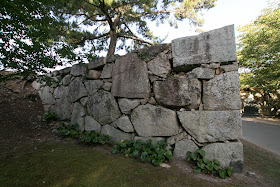












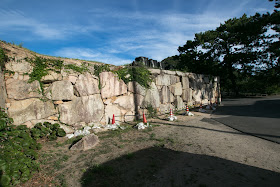




































































































































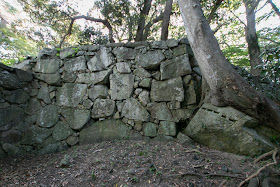




















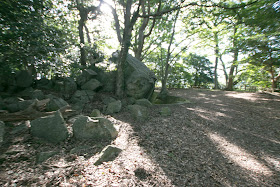

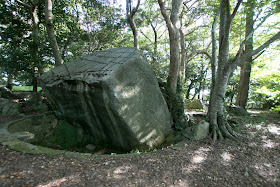























































































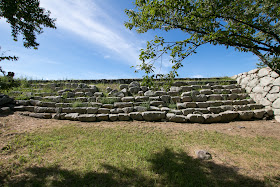










































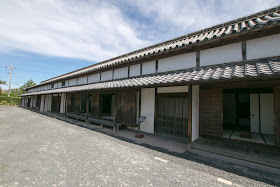

No comments:
Post a Comment